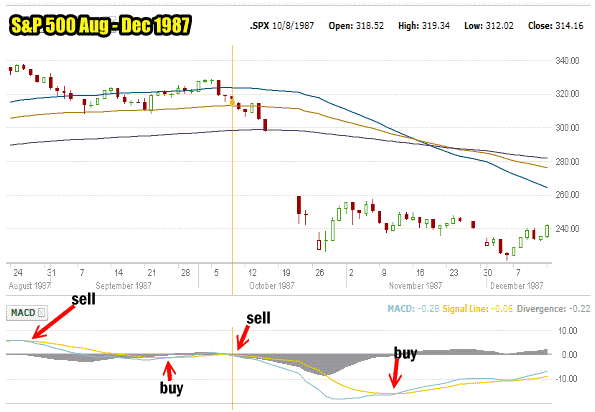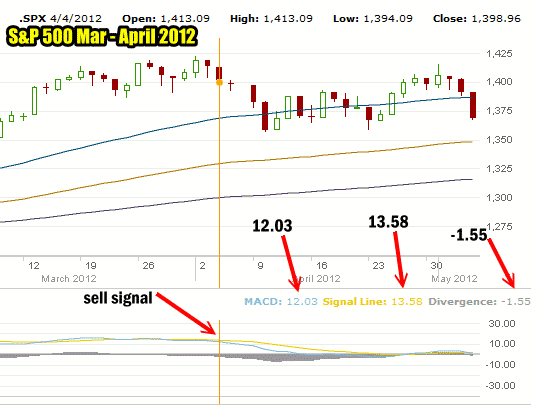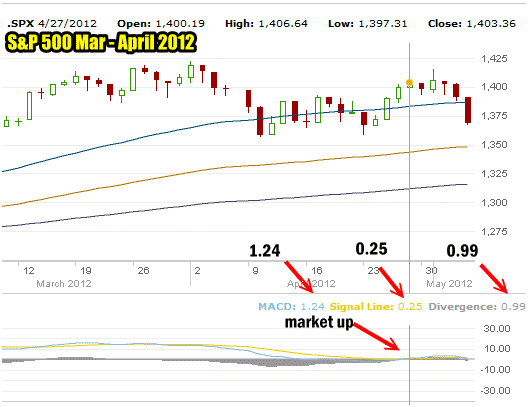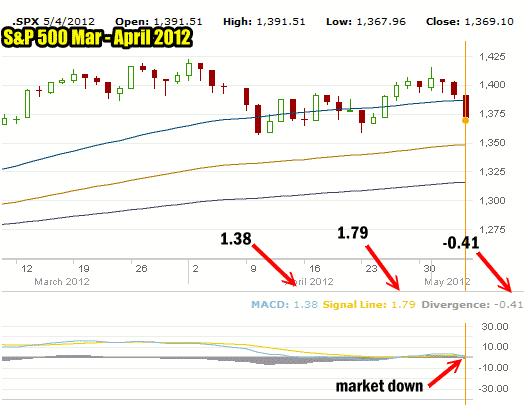MACD Histogram or Moving Average Convergence / Divergence is a unique and powerful tool that is used by many market timing systems including my own. I have used this tool since it was first introduced by inventor Gerald Appel in the late 1970’s. What is unique about this oscillator is that it is a trend follower made up of moving averages and momentum. MACD has kept me safe in many of the worst market environments. The histogram that can be used with MACD can be used to spot turning points in markets and stocks for entry and exit positions.
It is straight forward and easy to use MACD and as it offers trend following and momentum it makes a great tool to add to my overall stock market timing tools.
MACD Fall 1987 Sell Signals
For example in fall 1987 MACD warned that the market may be on the verge of a pullback. There is no way that it could predict the size of the pullback but then I don’t believe anyone or any tool can. The chart below shows the 1987 warnings and the subsequent 25% collapse of stocks.There were two sell signals and two buy signals generated. The last buy signal was excellent for a short-term bounce back in stocks.

In Fall 1987 MACD issued a sell signal before the market collapse
MACD APRIL 4 2012 Sell Signal
On April 4 MACD issued a sell signal as the signal line (yellow in my chart below) had a higher reading than MACD. The Signal Line reading was 13.58 while MACD was 12.03. The divergence was negative 1.55 marking a definite downturn.

MACD sell signal generated on April 4 2012
On April 27 the trend changed with a MACD reading of 1.24 and a Signal Line of 0.25 creating a positive divergence reading of 0.99.

MACD Market Up Call On April 27 2012
Today May 4 MACD generated another sell signal. The sell signal being so close to the previous market up signal, makes this sell signal important. Normally this marks a top, whether it is short-term or longer but it is very rare when the market can come roaring back up and recover to new highs. As well the fact that the Dow Jones set broke the high of 2007 and did not confirm it with any kind of follow through is in my opinion very bearish.

MACD Market Down Call Generated May 4 2012
MACD Used For Sell In May Theory
MACD is the principal timing tool used for the Sell in May theory which indicates that investors who are in stocks from the period of Nov 1 to April 30 fare better than those who were in from May 1 to Oct 31. Indeed a study done by Trader’s Almanac concluded that an investor who had placed $10,000 in the market in 1950 and stayed only for the November to April period would have about $600,000. At the same time an investor with $10,000 who invested only in the period from May to October since 1950 would today have $9621.00.
It should be pointed out that the period of November 1 to April 30 are not exact dates but are governed by a reading from MACD which tells the investor when to move back into stocks when the sell signal or buy signal is generated. It should also be noted that there was no study done of how well this investor would have fared by staying in the market during the entire time period.
MACD Sell Signal Summary
There are of course other factors to consider including that this is an election year and historically election years have decent summer periods and a poor April. Indeed April was poor this year and perhaps stocks will get a reprieve from the Sell In May theory. However as I indicated in yesterday’s market timing column, the market recently has seen too many stocks making 52 week highs. This is typical of a bull market drawing to a close as investors pile in at the end rather than back in October or November of 2011 when stocks looked poised to fall lower.
I will put up my market timing indicators tomorrow but they confirm what MACD is signalling. I felt there is enough indication in MACD, the number of new highs, the inability of the Dow to confirm the recent new high and the inability of the NASDAQ to continue moving higher even with the recent strong earnings from Apple and Amazon. With most of the earnings now in for the quarter we have a few months ahead with little earnings news. Many stocks in my opinion are not cheap. I can name many of them including Coca Cola Stock, Amazon Stock, YUM Stock, Priceline Stock and even PG Stock is pricey. A correction of 10 to 15 percent at this stage could set the market up to move higher later into the year.
While MACD could easily change signals within a few days, the markets themselves must regain too much momentum in too short a time to prove that this period of weakness is nothing more than a hiccup. I would prefer to be cautious and follow the advice given out by MACD.
